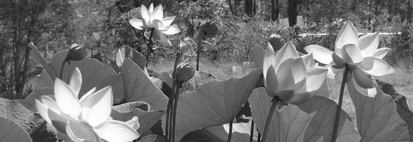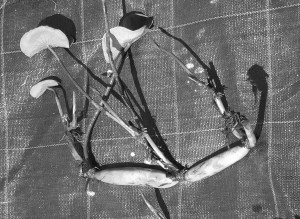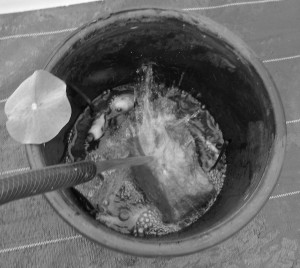Lotuses are water plants in the family Nelumbonacaea. There are two species of lotus; Nelumbo nucifera (sacred lotus) and Nelumbo lutea (Yellow lotus) . All lotus are hybrids between these two groups. Australian native lotus are in the Nucifera group.
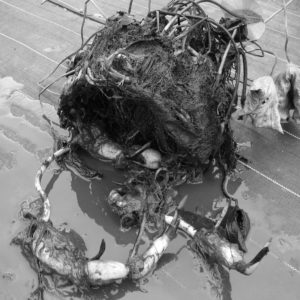 Lotuses have fully round leaves that are held on tall rigid stems well above the water surface. The leaves are waxy cool green and very decorative in their own right. Their flowers are very large, up to dinner plate size in varying colours from a true white, through cream, pinks, yellows and rose reds. Flowers are held well above the leaves and usually arrive during the hottest months of the year. Following the flowers the unusual central seed head grows and enlarges to form a chocolate coloured pod resembling an old fashioned shower rose. Lotus are winter deciduous ,once they have browned completely you can trim to water level.
Lotuses have fully round leaves that are held on tall rigid stems well above the water surface. The leaves are waxy cool green and very decorative in their own right. Their flowers are very large, up to dinner plate size in varying colours from a true white, through cream, pinks, yellows and rose reds. Flowers are held well above the leaves and usually arrive during the hottest months of the year. Following the flowers the unusual central seed head grows and enlarges to form a chocolate coloured pod resembling an old fashioned shower rose. Lotus are winter deciduous ,once they have browned completely you can trim to water level.
Edible Lotus –
Most parts of the lotus plant are edible. The leaves are dried and used to wrap sticky rice dishes and making tea. Seed can be eaten raw or made into a sweet paste. The tubers can be steamed, stewed or finely cut and deep fried to make crisps.
Basic Requirements-
Lotus prefer a silty soil at least 10cm deep with at least 10cm of water over this. To flower well they require lots of room for an excellent display we recommend at least a square meter pond at a total of about 40-50cm deep dedicated just to your lotus. However with care you can grow and flower lotus in smaller spaces. Large lotus can spread very rapidly and grow in water to two meters deep so care should be taken in where they are planted.
Mail order or bare rooted lotus plants should be one or two tuber sections with at least one end growing tip. Unwrap and handle the tuber very gently at all times, so as not to break the fragile growing tips. When you receive bare rooted lotus place it initially in a bucket of clean water in a warm place for a week or two till you see new bristly white root growth at the nodes of the tubers. Use a weight (like a brick or stone) to keep the lotus submerged during this time.
Once new growth has started prepare the lotuses permanent container or pond with about a 10cm layer of soil lightly fed with fertilizer. Plant your lotus into the soil so that the tuber is in the soil and the shoots are above in the water. You may need to place a small rock on the tubers to prevent them from floating. Gently add water to the pot or container until full. Choose a very warm and sunny location with some wind protection.
Re-potting Lotus –
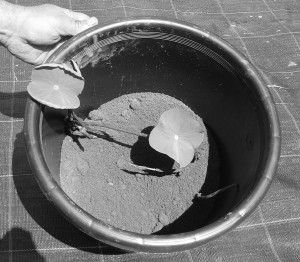 To promote strong growth of leaves and flowers lotus must be re-potted and thinned at least once every 2-3 years. When re-re-potting you should find a mass of old dead blackened material that should be discarded, and towards the bottom of the pot strong firm thick white tuberous material that forms the healthy new plant material you will want to replant. Select whole strong tubers with undamaged shoots and treat then as described in the getting started section.
To promote strong growth of leaves and flowers lotus must be re-potted and thinned at least once every 2-3 years. When re-re-potting you should find a mass of old dead blackened material that should be discarded, and towards the bottom of the pot strong firm thick white tuberous material that forms the healthy new plant material you will want to replant. Select whole strong tubers with undamaged shoots and treat then as described in the getting started section.
Feeding Your Lotus –
When the plant makes a couple of leaves on the surface of the water (called coin leaves) it is time to start feeding it with a small amount of fertilizer mix added directly into the water or into the root zone at the base of the stems. This is easily done by mixing a paste of organic fertilizer ( see note below) the paste helps the ingredients sink to the root zone where the lotus will quickly make use of it. Continue adding small amounts of fertilizer fortnightly, increasing amount or frequency in relation to the growth rate of the plant. The rule of thumb is to give the plant more feed as you see the plant grow larger. When the plant starts to slow down (early Autumn) to go dormant for winter stop feeding as soon as it stops producing new strong leaves.
In a container mix up equal amounts of crumbed dynamic lifter (or similar) and blood & bone and store in a dry place to use during the season as needed. Each fortnightly feeding of a lotus in a 33cm bucket should average a level desert spoon of this mix. But you should feed it less at first when the plant and leaves are small and more as the plant and leaves grow larger. Over an entire growing season about a standard cupful of this mixture should be sufficient for one plant in a 33cm pot .
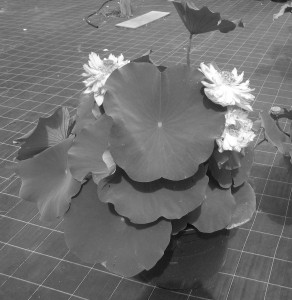 Any other fertilizer can be substituted but some fertilizers are much stronger and should be added in much smaller amounts than the standard recommended mix. It is fine to use different fertilizers and a varied mix over the season might be preferable.
Any other fertilizer can be substituted but some fertilizers are much stronger and should be added in much smaller amounts than the standard recommended mix. It is fine to use different fertilizers and a varied mix over the season might be preferable.
Lotus grown in a larger pond, container or volume of water require larger amounts of fertilizer in direct relation to the increase in water volume and the over all amount of growing plant matter.

